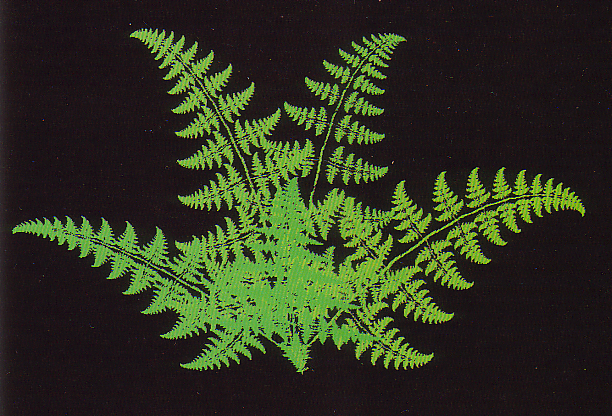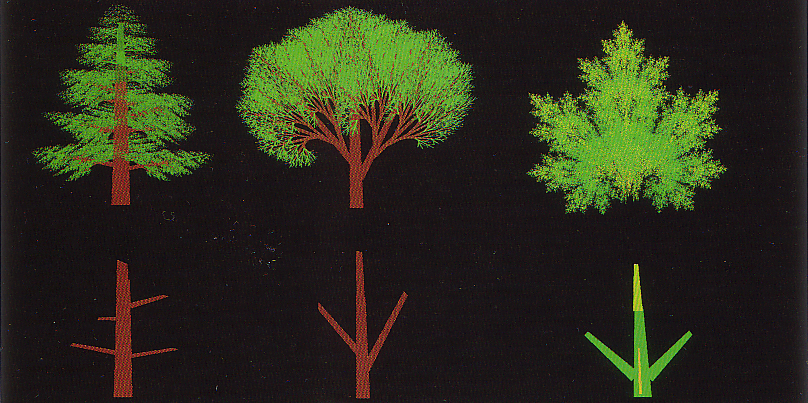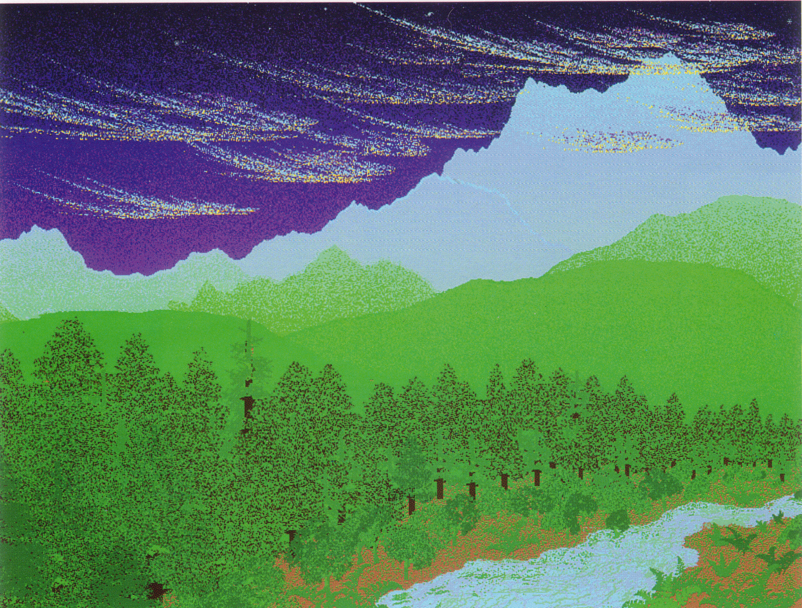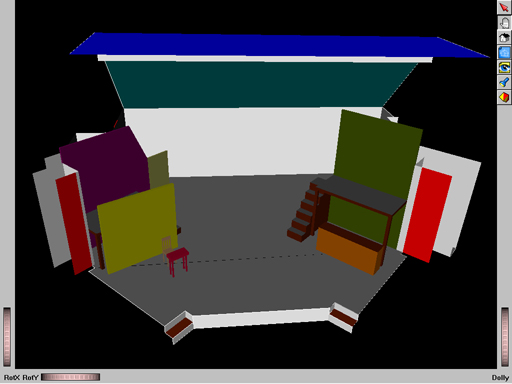Special Topics in Computer Graphics
References:
- Dick Oliver, "FractalVision - Put Fractals to Work for
You", Sams Publishing, 1992.
Up to this point we have covered some of the basic fundamentals
of computer graphics: Drawing pixels to a buffer, 3D polygon and
camera coordinates specifications, lighting & shading models,
texture maps, etc. This page looks at some special topics that
go beyond the basics, and at some of the followup courses students
may want to take next.
- One of the most important conferences and groups in the general
field of computer graphics is ACM SIGGRAPH, which is the Special
Interest Group on Graphics for The Association for Computing
Machinery. Online the SIGGRAPH home page may be found at http://www.siggraph.org/,
whose conference proceedings are available through the ACM Digital
Library.
Fractals
- The basic idea of fractals are to apply a mathematical equation
or algorithm to produce a structure with infinite detail no matter
how closely you zoom in, and in many cases to generate pretty
pictures as a result.
- One of the simplest and most common fractals is the Sierpinski
triangle, which starts with a simple equilateral triangle
and recursively sub-divides it, ( theoretically infinitely )
to generate an object with a finite area but an infinite boundary.
- A variation on the Sierpinski Triangle is the Koch
Snowflake, which again starts with an equilateral triangle,
but recurses by replacing each line segment on the current version
of the snowflake with a four-segment replacement having a triangular
"bump" in the center of the original line segment.
- Perhaps the most famous set of fractals is the Mandlebrot
Set, generated by recursively applying a simple mathematical
function to points in the complex plane:
- Define the region in the complex plane to be searched. The
entire Mandelbrot set is contained within the space +/- 2.0 +/-
1.5 j. ( The letter j is used for the complex square root of
-1 to avoid confusion with the incrementation variable i to be
used shortly. ) Define also the resolution with which to sub-divide
the space.
- For each point in the space:
- set Z_0 equal to X + Yj.
- Apply the recursion relation Z_i = ( Z_i-1 )^2 + Z_0, until
either the new Z_i exits the circle of radius 2.0 centered about
the origin, or until the maximum number of iterations has been
exceeded, ( counting the number of iterations required as the
recursion progresses. )
- Color the pixel according to how many iterations it took
to exit the circle, usually using a mod function into a list
of colors if the point exited the circle, and black otherwise.
- Based on the resulting image, select a new smaller region
to examine, and repeat the process.
- All those points for which the regression never leaves
the circle define the Mandelbrot set. It can be shown that this
set has infinite amount of detail, no matter how small an inspection
area you choose to look at.
- Joulia Sets are related to Mandelbrot sets. See the above
web pages for further details.
- In the field of computer graphics, fractals can be used to
generate realistic looking ferns, trees, mountains, clouds, and
many other natural looking phenomenon:



Scientific Visualization
Animation
- We have included some motion in CS 488, however the Computer
Animation course, CS 527, includes a much more in-depth look
at this particular aspect of Computer Graphics, including many
of the human factors issues dealing with how humans perceive
motion. Andy has not taught that course since 2001, but Andy
Johnson's CS 527 pages are still on line.
- One example of an animation project from CS 527 is the theatre
animation project, designed to plan and simulate set changes
for a small local theatre:

Virtual Reality
moved to a separate page
Human-Computer Interaction
- Very often in computer graphics the overall goal is to have
some effect on a human, and in order to do that most efficiently,
it is important to understand the human side of the equation,
and the interaction between the computer and the human. The CS
522 course focuses on this interaction, including input devices
such as mice, keyboards, and special devices as well as effective
computer graphics displays. Most recently this course has been
taught by Tom Moher,
but Andy
Johnsnon's CS 522 pages from 1998 are still available online
( from when the course was taught as EECS 578. )
- A somewhat related course is CS 422, User Interface Design.
This course focuses more on the practical aspects of developing
an effective user interface for a particular application, as
opposed to 522 which focuses more on the current and historically
important research in the field. Andy
Johnson's CS 422 pages are available online, and he is scheduled
to teach the course in Spring 2006.
- The predominant conference in CHI is the CHI conference,
whose home page may be found at http://www.chi2006.org/
and proceedings via the ACM
Digital Library.
Game Development
- Jason Leigh teaches an excellent course in "Video Game
Design and Programming", which appears officially on the
CS course descriptions as "CS 426 - Multimedia Computing".
Jason's CS 426 pages are currently online, but do not have a
separate URL. To find them, go to Jason
Leigh's Home Page, and follow links to "Extra",
and then "Classes I Teach". CS 426 is usually taught
in the Fall semester.
GPU Programming
- Modern Graphics Processing Units, GPUs, have developed incredible
power, often out-performing the CPUs that drive the main computer.
In addition, they are specially designed to perform operations
on the entire contents of large buffers with a single instruction,
which provides opportunities for some very interesting parallel
processing applications using these secondary processors. In
Spring of 2006 Andy Johnson will be teaching a new ( experimental?
) course in how to effectively use GPUs, titled CS 594, Special
Topics. Andy
Johnson's GPU Programming course pages are currently online,
though they are still preliminary as of this writing.
- Interested parties may also want to check out NVidia's
web site, and in particular NVidia's
Developer's site, where you can find SDKs for programming
NVidia GPUs, and full documentation on how to do so.




